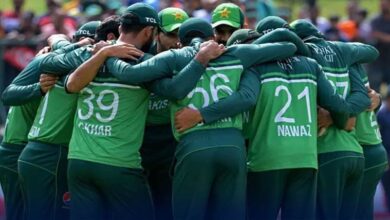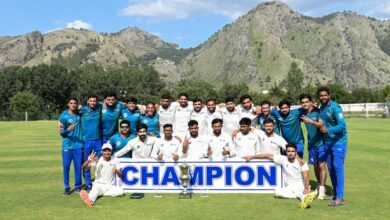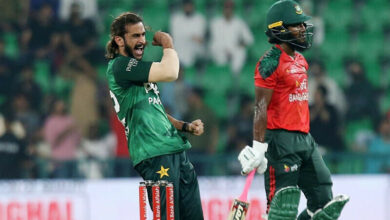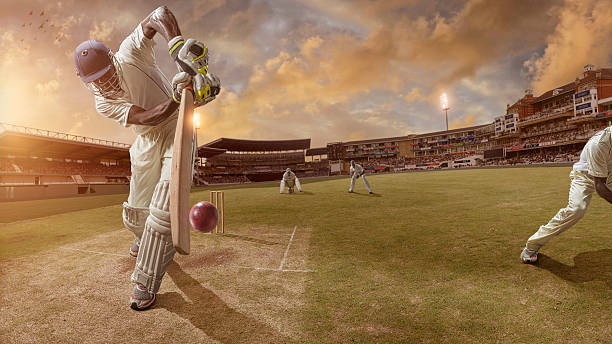

“All my cricket is watched while I’m working,” says the former captain of the Pakistan women’s team. On March 19, 2016, Urooj was fixing someone’s teeth, asking her assistant to – not provide suction – but hit refresh on the ESPNcricinfo scorecard for the World T20 game in Delhi, where Pakistan’s women fought tooth and nail to achieve their second win ever against India. The dying moments of that rain-affected match were beamed on prime-time television, and Urooj wasn’t the only one following along.
India v Pakistan women’s matches inspire their own distinct passion. You could see it in that game in Delhi, and again in Derby a year later at the 2017 Women’s World Cup. As the teams waited to take the field, the fans flanking them on the picketed steps let go – “Jeetega bhai jeetega” versus “Dil dil Pakistan”. The players, eardrums bursting, adrenaline coursing, struggled to keep it together.
This rivalry has been an interrupted one – over 12 years, the teams have met just 19 times – and one less storied than its male counterpart. Yet it is refreshingly more respectful, and it has already birthed some peculiar tales – of bones, stones, awkward tailoring jobs, and distracted dentists.

I have had a privilege that Virat Kohli, Harmanpreet Kaur and Smriti Mandhana have not, and the way things are going, probably never will: I have played cricket in Pakistan.
While India’s and Pakistan’s men’s teams were playing that otherworldly series in 2004, Pakistan women’s cricket quietly put itself on the map. In the same month that the men’s tour commenced, Kiran Baluch scored 242 against West Indies in Karachi, which displaced Mithali Raj’s 214 as the highest score in women’s Tests. That was also the first I heard about a Pakistan women’s team. Then came news that an Indian female junior side was to tour Pakistan.
The groundwork for this remarkable development – no female Indian cricket team, and few female sports teams, had toured Pakistan before – was laid by the men’s tour and the bonhomie it created. It helped that women’s cricket in Pakistan now had deeper pockets, having become, in 2003, the first Asian country to toe the ICC line and merge men’s and women’s cricket.
Soon after the men’s tour, Shubhangi Kulkarni, secretary of the Women’s Cricket Association of India, got busy on the phone. “We had a meeting in Lahore,” she remembers. “There was Mira Phailbus, president of the PCB women’s wing, and Gwen Herath from Sri Lanka. We decided to start the Asia Cup, the idea being to develop our teams.”
Pakistan were the new kids on the block and were concerned about being found out in senior cricket. “So we said, ‘Fine, we’ll help you’ll get some international exposure, we’ll send our Under-21 team,'” says Kulkarni, who was keen to build some bench strength for the Indian team too. The decision to host the series in Lahore, at the invitation of Phailbus, came as a relief to Kulkarni. “For us at that time fundraising was a huge issue. Every tour, I used to be worried whether we are going to make it. So when they offered, it was the best thing.”

The tour created buzz on the Indian junior circuit. Thirty U-21 players were picked for a camp. They included Karuna Jain and Rumeli Dhar, fresh from representing India at the 2005 World Cup. The camp was sponsored by the tech giant Infosys and held at the company’s campus in Mysore. For us players – used to sleeping in dorms and playing on rough outfields – the posh guesthouses and the lush green ground were the height of luxury. The former England international and ECB certified Level III coach Jane Powell was roped in to train us.
For most of the squad, Lahore was our first away tour, our first brush with coloured clothing and white balls, and our first taste of the atmosphere in international cricket. For the baby of our team, MD Thirush Kamini, the cricketing exposure would help when she made her ODI debut the following year against the same opposition at the age of 16. But the cultural exposure was just as valuable. “One thing I remember,” Thirush Kamini says, “the [opposition] wicketkeeper wore a scarf [hijab]. I didn’t expect it, and as a batter, she was just behind me. It was very strange for me. I didn’t have any sort of problem, but it looked different.”
The cricket itself was underwhelming. We beat Pakistan 4-0, and might have done so even without Jain and Dhar. But we were given the best of facilities, two games at the Gaddafi Stadium, as well as the whole shebang when it came to security, including armed guards for our shopping excursions.
Though we were blown away by the famous Lahori hospitality, not all of us were happy; I still remember the look on my vegetarian state-mate Anagha Deshpande’s face when one day she found a bone in the veggie pulao that she was subsisting on. Suffice to say that she lost some weight on the trip.
On an administrative and diplomatic level, the tour was a success. Sadly, it remains the only bilateral women’s cricket series between the two countries.
Think of the 2005 tour by the U-21 team as the dipping of a drumstick in the Amazon to see if there truly are piranhas in it. Kamini’s mother, for instance, prayed every day for the safe return of her daughter, despite the abundant security and the warmth of the people of Lahore. All fears having been proved simply fears, the senior India women’s team soon went across the border. Between them, the two teams had played 195 international games until that point; now India and Pakistan women were set for their first encounter against each other, in the Asia Cup of 2005-06 in Karachi.

When the team got to Pakistan the first wicket fell to mehman nawazi [hospitality]. Jaya Sharma remembers carrying a “fear factor” on the flight to Karachi, “but when we landed there and saw the hospitality, it was fun”. Sharma made her first ODI hundred on that tour, feasting on the Pakistan bowling as she did on the food on the tour.
Jhulan Goswami has similar memories. “I remember the taur tarika [ways and habits], the friendliness of the players. It doesn’t feel like it’s a different country, different people, different place. Secondly, Pakistan ke saath khelne ka jo maja aata hai , wo kisi aur ke saath khelne me nahi aata.” [The fun of playing Pakistan is unique.]
The feeling was mutual.
“The India-Pakistan craze was so much that us, as a developing team, would end up having more of a verbal argument with your side, rather than focusing on cricket,” says Urooj, who would soon take over the reins of the national team. “Chhodenge nahi, yeh kar denge, woh kar denge” [We won’t let them go, we are going to beat them.] Unperturbed, India returned champions, beating Sri Lanka in the final.
The Indians gave back on the verbal front back when Pakistan arrived in Jaipur for the second Asia Cup, in late 2006. But it was the crowd doing the talking more than the players. For Pakistan, it was their first time playing in front of large mixed crowds; back home, only women and families were allowed into grounds to watch women’s cricket.
“Yes, it was different and the chants were quite different,” says the veteran Sana Mir with a chuckle. “With families, people are more appreciative and courteous, but with single men coming to see a women’s match, the slogans and the chants become quite different. They were expressing their love for certain players, which was quite funny for us, because in Pakistan people are not so expressive. At first not many girls would want to go out and field at the boundary. Then they got used to it and saw the humour in it.”

I suspect Mir is being kind in her descriptions. Having experienced Indian crowds at the boundary myself, the comments probably objectified the players more than she lets on.
For Urooj, who led the side, it was a homecoming of sorts. “I have a lot of family in India. I would go to India for family holidays, but to be in a national blazer, representing the country, as captain… [I was] trying to give right answers, do the right thing, presenting yourself nicely. India-Pakistan, anything becomes a big deal.”
The series was restricted to just the one venue, Jaipur, for security reasons. It was the first home series under the BCCI umbrella, and most of the security arrangements were provided by the Ministry of External Affairs. Yet there was a serious scare when stones were thrown at the Pakistan team’s bus as it left the ground after a match against India. “I think all the girls were so young, we would just laugh at everything,” Urooj says. But Mir admits to being worried. “I think a few [stones] did touch our window. It was a 10-15 minute incident, on our first tour to India. Definitely was a bit scary at that point.”
The incident was a stark contrast to the rest of their experiences on the tour, where they visited markets and monuments with light security, and received much love from the locals. “In the same visits,” says Mir, “we would see two different sides of people in the same country, two different attitudes.”
The on-field needle continued into the 2008 Asia Cup in Sri Lanka. India and Pakistan played each other twice (the second game was my ODI debut). In the first match, Jaya Sharma and Asmavia Iqbal, who had spent time shopping together in Karachi in 2006, got into a bit of an altercation.

With India in control of the match, Iqbal blocked most of the 83 balls she faced on her way to 8, helping the last pair bat out ten overs. “Maarne ki bhi rakhi hai” [You should be trying to hit as well] said a frustrated Sharma at one point. Iqbal lost no time in reminding her that Sharma had lasted all of two balls for a duck when India batted. “Ao humse sikh lo kaise khelte hain” [You could learn how to play from me.] Things got heated; the umpires had to calm the players down, and the two did not shake hands after the game. Then India coach Shanta Rangaswamy intervened, leading to an amicable end and an eventual handshake.
Six months after that tournament, in November 2008, came the terror attacks in Mumbai, sinking all the goodwill that had been built between the countries over the previous five years. So it helped that the next time the two teams met was in the 2009 World Cup in Bowral, Australia, far from the hype of the subcontinent, and at a time when the media was busy with speculation about where and how the IPL would be played.
That tournament was special for the captains of both teams, one newly minted, the other in the twilight of her career. Jhulan Goswami was heading into her maiden World Cup, having been given the leadership just one series earlier. And the first game was against Pakistan, which meant a soft start in theory, but also a hard fall should there be an upset.
“It was my most important match against Pakistan, when I was the most nervous,” Goswami says. “That match, it is very close to me. I still remember, the whole night I could not sleep. I would keep checking my mobile to see what the time was, hoping I haven’t overslept.”
In the end, Goswami had time for an afternoon nap; India bowled Pakistan out for 57 and secured a quick ten-wicket win. Goswami took one wicket in the game, bowling her opposite number, Urooj, whose parents arrived soon after the game had ended, having flown in especially to watch it. “When they got to the match, the trainer was going through the cool-downs, and so my parents literally thought we were warming up,” she laughs. “They thought the match was delayed for some reason. One of my not-so-happy memories.”
It wasn’t all bad for Pakistan. They had been handed their return tickets before the tournament began, but they beat Sri Lanka and booked a place alongside India in the Super Six, forcing the ICC to revise their bookings.

Four to win off the last ball. Niranjana Nagarajan hits the ball into the outfield, but the fielding is good and the eighth Indian wicket falls as the batsmen try to sprint for the third run that will tie the game. The stadium is placed between the Indian Ocean and Galle Fort. Pakistan could not have picked a more picturesque setting, or more dramatic circumstances, for their first win ever against India, by just one run.
“That was the first time a Pakistan team, men or women, had beaten India in a World Cup,” says Mir, who captained in that 2012 World T20 game. “We had a mental block before that that we could not beat India because we had never beaten them.” The pressure then shifted to India every time they played Pakistan.
“For me, I don’t see Pakistan as a different side,” says the current India captain, Mithali Raj. “But when you play Pakistan, it’s a lot to do with other people than the team. Like family, friends, they kind of put this pressure. ‘You have to win against Pakistan, whether you win or lose against any other team, you have to win against them,’ stuff like that. That adds pressure to the team more than anything else.” India’s younger players, Harmanpreet Kaur chief among them, responded to the increased pressure by being at their most verbal in India-Pakistan games.
Raj says a line was crossed in the 2014 WT20 in Bangladesh. “It was my first taste of – I can’t really call it sledging, because certain terms are not used in sledging. Sledging is where you try to divert the focus of a player. But when you have some terms used, it gets far beyond sledging, which was used against me in that match. Of course I felt very bad, because in my entire life people have not abused me.”
Raj expressed her concern to the match referee after the game, which India won by just six runs (incidentally, although it was an ICC tournament, the match referee was Indian).

Off the field, too, tensions were high in that period. Just a year earlier, the Pakistan women’s team was forced to move their 2013 World Cup games to Cuttack after threats from the right-wing political outfit Shiv Sena about playing in Mumbai. In Cuttack, the players were confined to living quarters within the stadium. While Mir was stoic, saying the focus was on the cricket, she did rue the lost chance for her team to breathe in the World Cup atmosphere.
“At that point I had a lot of youngsters in the team, many were playing their first World Cup. They did not get any kind of feeling of what a World Cup is like,” Mir remembers. “We were not at the opening ceremony, we were not with other teams. Sometimes you catch up with a player in a lobby or a pool or gym. Chats like these make you comfortable at the international level.”
Still, Mir complimented the Indian staff at the Barabati Stadium, revealing how they brought in sari merchants to compensate for the players not being able to go shopping. And the New Zealand side invited them over to their dressing room after a match, a gesture that Mir still talks highly of as a bright spot on a grim tour. Pakistan lost every game on that tour, their last to India.
Derby, 2017. Just outside the Indian dressing room, Pakistan medium-pacer Kainat Imtiaz paints a circle with her words as she speaks to Jhulan Goswami. Imtiaz was a ball kid in Karachi in the Asia Cup of 2005-06, and was inspired to bowl fast after she watched Goswami steam in. This was a fitting final piece in a 20-year-old jigsaw, considering Goswami herself was a ball kid at the 1997 Women’s World Cup final, which inspired her to take up the sport.
“I can say I have been able to motivate one girl in this world to play cricket, that too from Pakistan – that was a big thing for me,” says Goswami.
Romantics will wonder how many more of these stories would arise if only the two teams played each other more often – or if the players played on the same side. From one such rare occasion comes the tale of Sana Mir’s trousers. Turning out for Rest of the World against the MCC in 2014, Mir received a pair that was too long. “I wanted to cut it, so I remember Shashikala [Siriwardene of Sri Lanka] and Goswami helped me, and what happened was one leg was long and the other leg was short. We really laughed about it; India, Sri Lanka and Pakistan working on one trouser and we could not get it right!”

Mir took 4 for 36 in that game, so it clearly wasn’t that bad a job. The India and Pakistan women had shared dressing rooms once before, in the Afro-Asia Cup in 2007. “At that point Mithali and Jhulan were big names in women’s cricket, we were still quite young,” says Urooj, who was one of two Pakistanis in the Asia team. “So it is exactly like how a youngster nowadays feels playing in the IPL with big stars.”
Raj recalls the messages of support ahead of big games or after major wins from Pakistani players, some of whom she calls friends. “I think it was when we were in Australia and we won the T20I series, that time they were rooting for us,” she says. “Even in the [2017] World Cup in the semi and in the final, they were rooting for us. When we play other nations, we team up as Asians.”
And yet all future bilateral series, mandated by the ICC Women’s Championship, are hostage to politics. Administrations could be held retrospectively guilty for not putting together more matches in friendlier times. Ten ODIs and nine T20Is in 12 years is not much of a legacy.
No contest, no rivalry, should be denied moments like this final one, again from the match Urooj was following on ESPNcricinfo with her fingers in some unlucky patient’s mouth. That game in Delhi is also Mir’s favourite India-Pakistan experience, and not just because it was a win in front of a partisan but appreciative crowd. “Before the game, we walked out for the anthems with young kids,” Mir says. “After the anthem, the child I was standing with turned to me and said, ‘All the best.'” An Indian child wishing the Pakistan captain good luck before the game. “These kind of things leave an impact on you as a human being and as a cricket player.”




